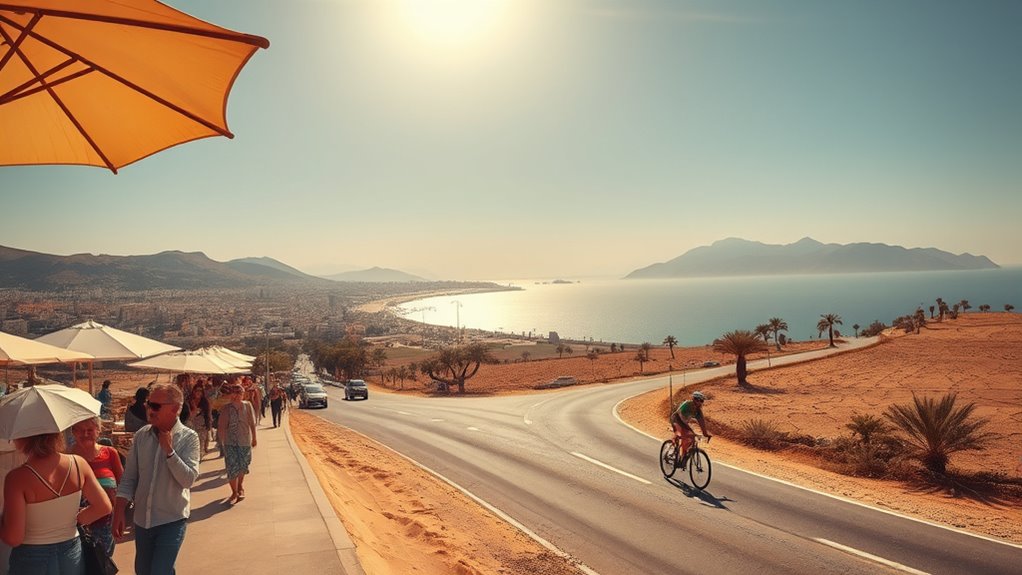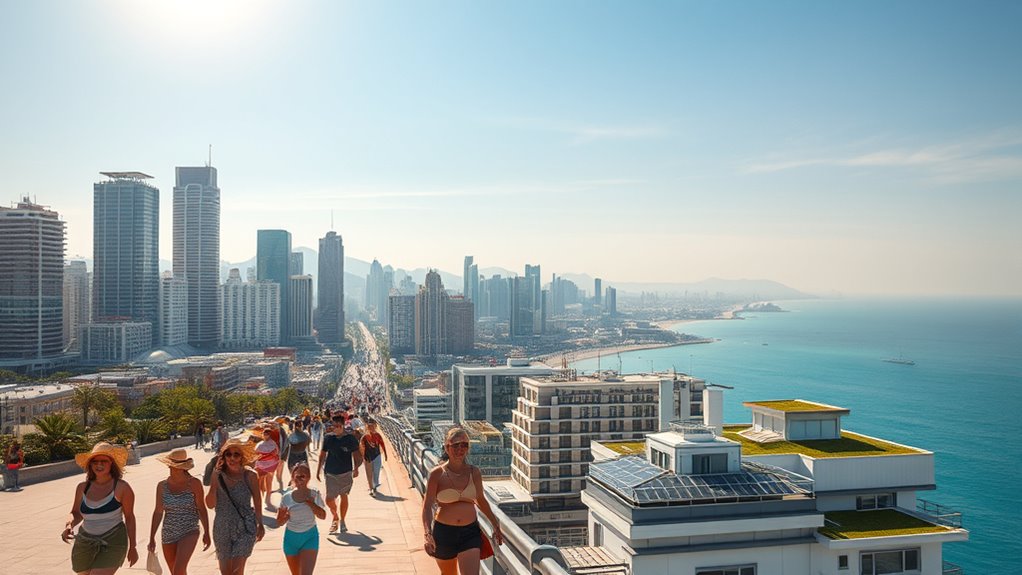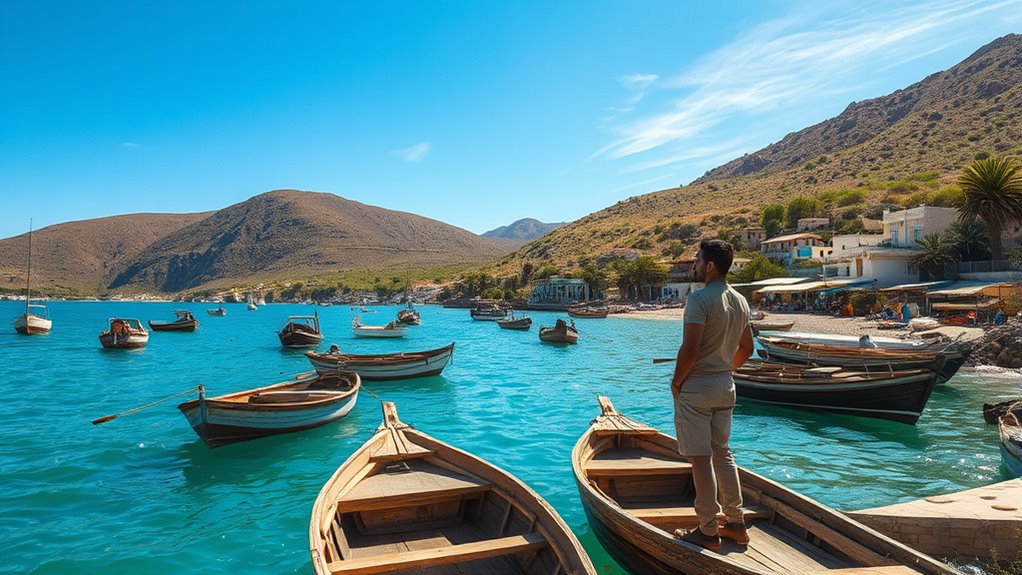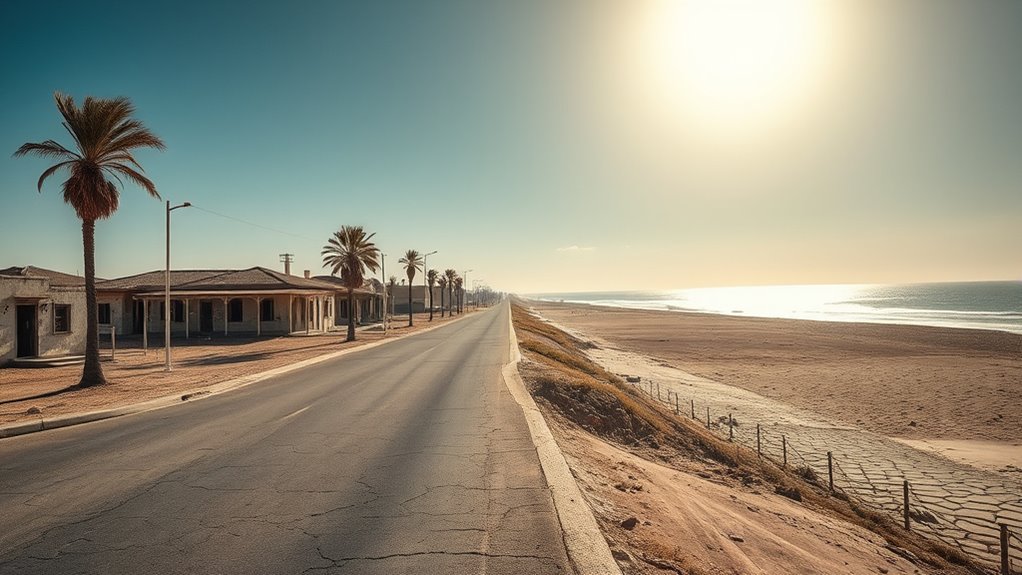As climate change heats up the world, you’ll notice shifts in travel habits, like avoiding peak heat hours and choosing cooler destinations such as northern or high-altitude areas. Public transit use drops during heatwaves, while private cars and air-conditioned facilities become more popular. Industry efforts focus on reducing emissions and promoting sustainable travel options. If you want to explore how these changes affect your future trips and destinations, there’s plenty more to uncover.
Key Takeaways
- Travel patterns shift toward cooler destinations and seasons to avoid extreme heat and weather disruptions.
- Increased use of air conditioning and vehicle modifications are adopted for comfort during travel in hotter climates.
- The tourism industry promotes sustainable practices like eco-friendly accommodations and emission reduction strategies.
- High-altitude and northern regions become preferred travel spots due to their resilience against climate impacts.
- Natural attractions face degradation from climate change, prompting a focus on sustainable tourism and conservation efforts.
Changing Travel Patterns in Response to Heat Waves and Extreme Weather

How do heat waves and extreme weather events reshape your travel habits? Urban heat markedly influences your travel adaptations, making you rethink how and when you travel. During intense heat, public transit usage drops nearly 50%, as you prefer private vehicles with air conditioning. Heat islands in cities intensify discomfort, prompting more indoor activities and less outdoor exploration. Extended heat waves lengthen travel periods, disrupting routines and pushing you to avoid peak heat hours. Rising temperatures also shift travel seasons, with many opting for spring and autumn trips to dodge the summer heat. Vulnerable populations, including the elderly and children, are especially affected, often reducing outdoor travel altogether. Additionally, extreme heat significantly reduces time spent outside homes, leading to decreased outdoor leisure, shopping, and social trips. These changes highlight how climate impacts your mobility, requiring you to adapt your plans to stay safe and comfortable amid rising urban heat. Moreover, the need for vehicle modifications, such as enhanced air conditioning systems, becomes more important as people seek relief from the heat while traveling.
The Carbon Footprint of Tourism and Industry Initiatives for Reduction

Tourism markedly contributes to global greenhouse gas emissions, accounting for about 6.5% in 2023, with transportation being the primary source. To reduce this footprint, industry initiatives focus on several strategies:
- Promoting carbon offsetting projects that balance emissions through reforestation and renewable energy investments.
- Supporting eco-friendly accommodations that utilize renewable energy, water-saving systems, and waste reduction.
- Encouraging travelers to choose more sustainable transportation, like trains over planes when possible.
- Setting ambitious targets through frameworks like the WTTC decarbonization roadmap, which guides businesses to lower their carbon intensity.
- Glycolic acid products and treatments can also play a role in promoting skin health for travelers, especially those exposed to varying climates.
While progress is evident—emissions per unit GDP dropped by 10.2%—challenges remain, especially with aviation’s tough decarbonization. In 2023, Travel & Tourism accounted for 6.5% of global emissions, down from 7.8% in 2019, yet, collective efforts can help travel grow more sustainably.
Shifting Preferences Toward Cooler and Less Vulnerable Destinations

As travelers become more aware of their environmental impact, many are opting for destinations with cooler climates to escape the intensifying heatwaves and climate-related disruptions. This shift influences seasonal travel patterns, as you seek out higher-altitude or northern locations that offer relief from extreme temperatures. Cooler destinations not only provide comfort but also reduce the risk of weather-related disruptions like storms, floods, and wildfires. Cultural tourism in these areas often gains popularity, as travelers explore less vulnerable regions with rich histories and traditions. Many choose sustainable destinations that prioritize low-carbon practices, aligning their travel with environmental responsibility. By favoring cooler, less climate-sensitive spots, you’re helping to mitigate heat-related risks while enjoying authentic cultural experiences in safer environments. Additionally, the impact of climate change on agricultural production, including tea cultivation, underscores the importance of adaptable and resilient travel choices.
The Future of Iconic Natural Attractions Amid Climate Challenges

Iconic natural attractions are facing unprecedented threats from climate change, transforming landscapes that once seemed timeless. Glacial retreat, for example, has caused Glacier National Park to lose up to 85% of its glaciers since 1966, disrupting ecosystems and water sources. Similarly, coral bleaching threatens the Great Barrier Reef’s biodiversity, with rising ocean temperatures and acidification weakening reefs and endangering thousands of species. As climate change accelerates, expect:
- Continued glacial melt, reducing ice-dependent landscapes and altering downstream ecosystems. The loss of glaciers also diminishes freshwater supplies, impacting both wildlife and human communities.
- Increased coral bleaching events, leading to reef degradation and loss of marine life.
- Rising sea levels causing erosion and submersion of coastal landmarks.
- Habitat loss for species relying on these iconic sites, diminishing their cultural and tourism appeal. The loss of glaciers and coral reefs also threatens the livelihoods of communities dependent on sustainable tourism and fishing industries. These changes threaten the very essence of these natural wonders, challenging their future preservation.
Strategies for Sustainable Tourism in a Warming World

Climate change is reshaping natural attractions and the way people experience them, prompting the travel industry to adopt more sustainable practices. To do this, focus on eco lodge development that minimizes environmental impacts and promotes regenerative travel—restoring ecosystems and supporting local communities. Engaging local populations ensures tourism benefits are shared and resilience is strengthened. You should prioritize community-centered ecotourism, which fosters authentic experiences and supports conservation efforts. Destination management strategies, like promoting off-peak travel and implementing flow control, help reduce ecological stress. Additionally, integrating sustainability into policies encourages zero-carbon or carbon-negative travel options. By combining eco lodge development, local community engagement, and responsible planning, you can help create a more sustainable tourism industry that adapts to our warming world. Incorporating mindful planning can further enhance the resilience of tourism destinations in the face of climate challenges. Tourism is expected to produce 6.5 billion metric tons of carbon by 2025, highlighting the urgent need for sustainable solutions.
Frequently Asked Questions
How Will Climate Change Affect Global Tourism Employment and Local Economies?
You’ll see climate change cause significant shifts in tourism employment and local economies. As heatwaves and flooding threaten infrastructure, employment shifts toward sustainable and resilient sectors emerge. Economic diversification becomes essential to reduce reliance on vulnerable coastal tourism. Communities that adapt with new skills, eco-friendly initiatives, and diversified tourism offerings can better stabilize jobs and economic growth, even as climate impacts reshape traditional tourism patterns and challenge local economies’ stability.
What Role Do Governments Play in Promoting Sustainable Tourism Amidst Climate Threats?
Imagine you’re in a time machine, and your journey highlights how governments promote sustainable tourism amid climate threats. Your government leads policy initiatives aligned with UN SDGs, enforces environmental regulations, and offers incentives for eco-friendly practices. They also boost public awareness campaigns to educate travelers and industry players alike. These actions foster responsible tourism, protect ecosystems, and ensure cultural preservation, all while adapting to climate challenges and encouraging global cooperation.
How Can Travelers Effectively Reduce Their Personal Carbon Footprint When Traveling?
To effectively reduce your personal carbon footprint when traveling, you should prioritize eco-friendly transportation options like trains, cycling, or walking. Consider carbon offsetting for unavoidable emissions, and choose airlines investing in sustainable aviation fuel. Opt for accommodations with eco-certifications and support local, environmentally conscious businesses. Planning your route, traveling light, and using digital check-ins also help minimize energy use and emissions, making your travel more sustainable.
Will Technological Innovations Fully Offset Tourism’S Environmental Impact?
You might wonder if tech innovations can fully offset tourism’s impact. While renewable energy and eco-friendly technology are making strides—like electric planes and smarter travel planning—they can’t entirely eliminate emissions yet. You should know that these advancements help reduce emissions, but behavioral changes and sustainable practices remain essential. Relying solely on technology isn’t enough; combining it with responsible travel is key to minimizing your environmental footprint.
How Might Climate Change Influence the Development of New Travel Infrastructure?
When developing new travel infrastructure, climate change pushes you to prioritize resilient infrastructure and eco-friendly design. You’ll need to upgrade roads, bridges, and airports to withstand rising sea levels, storms, and heat-related damage. Incorporating climate projections into planning helps mitigate future costs and disruptions. By focusing on sustainability and resilience, you guarantee your infrastructure remains functional and safe, even as changing climate conditions threaten your transportation systems.
Conclusion
As you plan your travels, remember that global tourism accounts for nearly 8% of greenhouse gas emissions. With heat waves becoming more frequent, you’ll likely choose cooler, less vulnerable destinations. Adapt your travel habits now—support sustainable initiatives and opt for eco-friendly options—to help protect iconic sites and reduce your carbon footprint. Every small change counts in creating a resilient, responsible travel future in our warming world.









